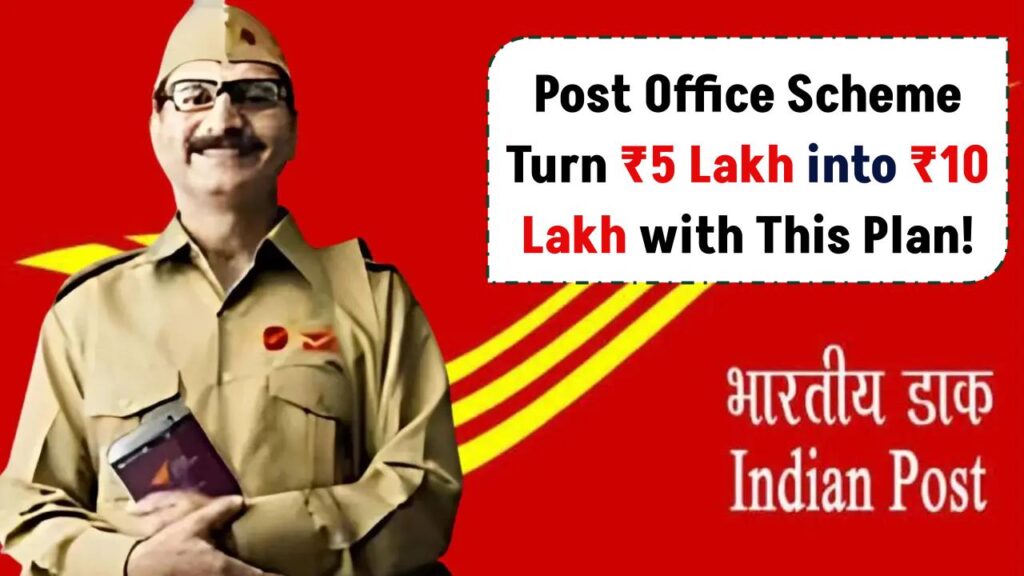
Investing wisely can help secure your financial future, and one of the safest options in India is Post Office Savings Schemes. Among these, the Kisan Vikas Patra (KVP) stands out as a reliable investment tool that can double your money over a fixed period. If you’re wondering how to turn ₹5 lakh into ₹10 lakh, this article provides a step-by-step guide to help you get started.
What is Kisan Vikas Patra (KVP)?
Kisan Vikas Patra (KVP) is a government-backed savings scheme offered by the Indian Post Office. It was introduced to encourage long-term savings and is especially popular among risk-averse investors looking for guaranteed returns.
The scheme works on a compound interest basis, where your money grows steadily over time. The biggest advantage? Your investment amount doubles upon maturity, making it a great option for wealth accumulation.
Benefits of Investing in KVP
- Guaranteed Returns – The scheme is backed by the Government of India, making it 100% risk-free.
- Fixed Interest Rate – As of 2024, the interest rate is 7.5% per annum.
- No Market Risks – Unlike stocks or mutual funds, KVP is not affected by market fluctuations.
- No Upper Limit on Investment – You can invest as much as you want, with a minimum of ₹1,000.
- Easily Transferable – KVP certificates can be transferred from one person to another.
How to Invest in Kisan Vikas Patra
Investing in KVP is straightforward. Follow these simple steps to get started:
Step 1: Visit Your Nearest Post Office
Since KVP is a post office savings scheme, you’ll need to visit a Post Office branch to open your investment.
Step 2: Fill Out the KVP Application Form
You can collect the form at the post office or download it from the official India Post website. Fill in your details correctly.
Step 3: Provide Required Documents
You need to submit the following documents:
- Identity Proof – Aadhaar Card, PAN Card, Passport, Voter ID, or Driving License.
- Address Proof – Aadhaar Card, Utility Bills, or Bank Statement.
- Passport-size Photographs
Step 4: Make Your Investment
The minimum investment amount is ₹1,000, and there is no upper limit. You can deposit the money in cash, cheque, or demand draft.
Step 5: Receive Your KVP Certificate
Once the application is processed, you will receive a KVP certificate as proof of your investment. Keep it safe, as you will need it at the time of maturity.
How Your ₹5 Lakh Becomes ₹10 Lakh
With an interest rate of 7.5% per annum, KVP follows the Rule of 115, meaning your money doubles in approximately 9 years and 7 months.
| Investment Amount | Maturity Value | Time Required |
| ₹5,00,000 | ₹10,00,000 | 115 months (~9 years, 7 months) |
| ₹10,00,000 | ₹20,00,000 | 115 months (~9 years, 7 months) |
Things to Consider Before Investing
1. Lock-in Period
Your investment is locked in for 2.5 years. If you need money before this period, you won’t be able to withdraw it.
2. Taxation on Interest Earned
The interest earned is taxable under “Income from Other Sources”. However, TDS (Tax Deducted at Source) is not applicable, making it easier to manage your taxes.
3. Premature Withdrawal Rules
You can withdraw your money only after 2.5 years, but you may face penalty charges depending on the withdrawal time.
4. Is it Better Than Fixed Deposits (FDs)?
Compared to Fixed Deposits (FDs), KVP has a longer maturity period but offers better returns due to compounding.
| Feature | Kisan Vikas Patra (KVP) | Fixed Deposit (FD) |
| Interest Rate | 7.5% per annum | 5.5%-7% per annum |
| Time to Double | ~9.5 years | ~12-14 years |
| Market Risk | No | No |
| Tax Benefits | No | Yes (on 5-year tax-saving FD) |
Post Office KVP Scheme (FAQs)
1. Is KVP a safe investment?
Yes, KVP is 100% safe as it is a government-backed scheme.
2. Can I withdraw money before maturity?
Yes, but only after 2.5 years, and there may be a penalty.
3. Does KVP offer tax benefits?
No, interest earned is taxable. However, TDS is not deducted.
4. Who can invest in KVP?
Any Indian citizen above 18 years can invest. NRIs are not eligible.







2 thoughts on “Post Office Scheme: Post Office’s great scheme, 5 lakhs will become 10 lakh rupees, start investing like this”